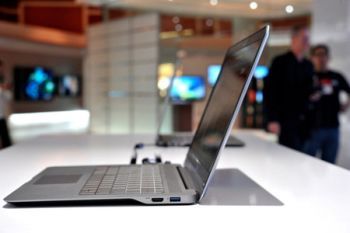
Publisher:
Bonnie King
CONTACT:
Newsroom@Salem-news.com
Advertising:
Adsales@Salem-news.com

~Truth~
~Justice~
~Peace~
TJP
Jun-29-2012 17:05

 TweetFollow @OregonNews
TweetFollow @OregonNews
Lighter Laptops Sacrifice Longevity
Andrea Eldridge for Salem-News.comIf you’re in the market for this unquestionably beautiful, super lightweight machine, factor the true cost.
 Courtesy: bestthinlaptops.com |
(REDDING, CA.) - When it comes to portable electronics, bigger is not better. From the new line of UltraBooks announced at this year’s Consumer Electronics Show to the highly anticipated MacBook Pro with Retina Display released by Apple this month, laptops are getting ever smaller and lighter to compete with the growing popularity of tablet PCs.
Yet with a smaller footprint comes limitations. When they’re impossible to upgrade and more costly to repair, is smaller truly superior?
If you are going to carry a device in your bag most everywhere you go, lightweight and durable is of paramount importance. To accommodate the increased demand for smaller, thinner, and lighter portable electronics, manufacturers are changing the way they construct laptops.
The MacBook Pro with Retina Display released to market this month by Apple has taken the trend to an extreme. To make it super thin and lightweight, most all of the components are built in to the machine making them either impossible or very expensive to replace. The RAM is soldered to the logic board. The battery is glued to the case. The display is fused to the glass.
Integrated hardware isn’t a concept new to laptops - the majority of laptops have “on-board” video cards and PCI ports, making it impossible to upgrade the graphics capability or add ports without modifying the motherboard. These manufacturing choices reduce size and weight - gluing and welding parts together means that the space for screws and removable access covers can be eliminated.
Yet it’s important for consumers to understand the limitations these design changes impose on the ability to repair or upgrade their device. RAM is the hardware item most often upgraded after purchase to extend the usability of a computer. Attaching the RAM to the logic board makes it impossible to upgrade after purchase. If a RAM module fails (this is common), you’ll likely be shipping your laptop back to Apple for it to be rebuilt with a new chip. You’ll have to max out the RAM upon purchase (and therefore pay top dollar to Apple for the upgrade on the front end), since there’ll be no increasing your system memory in two years when it starts to feel sluggish.
Batteries in rechargeable electronics inevitably fail; luckily, most laptop batteries are easily replaced. Most major-manufacturer laptops have inexpensive, 3rd party batteries available that the average consumer can replace with a couple of turns of a screwdriver. When the battery is instead glued to the case, the average consumer will not be able to easily replace it. The new MacBook Pro’s battery is reported to last through 1,000 cycles of fully discharging and recharging. What happens when it inevitably dies? Replace your system, or mail it back to Apple for a new battery (estimated $200).
Cracked screens are another common laptop problem. By fusing the display to the glass, Apple is requiring that the entire (expensive) display assembly be replaced, instead of simply the LCD.
Before you shake your fist at Apple for selling a system that requires either regular replacement (a $2,200 “disposable” laptop?) or costly manufacturer repairs when components fail (as they inevitably do), it’s important to note that Apple is not alone in moving in this direction. Therefore it’s up to you, the consumer, to decide if it’s worth the trade off. Does size and weight reduction warrant cost-prohibitive repairs and upgrades?
The MacBook Pro with Retina Display starts at $2,199 so I am loath to treat it as expendable. If you’re in the market for this unquestionably beautiful, super lightweight machine, factor the true cost. Consider maxing out RAM and storage upon purchase and adding on extended Apple care to warranty against cost-prohibitive repairs.

Andrea Eldridge is CEO of Nerds On Call, which offers onsite computer and laptop repair to homeowners and small businesses. Based in Redding, Calif., it has locations in five states. Contact Eldridge at www.callnerds.com/andrea.
About Nerds On Call
-------------------------------
Tweet
Follow @OregonNews
 |
 |
 |
 |
 |
 |
 |
Articles for June 28, 2012 | Articles for June 29, 2012 | Articles for June 30, 2012
Quick Links
DINING
Willamette UniversityGoudy Commons Cafe
Dine on the Queen
Willamette Queen Sternwheeler
MUST SEE SALEM
Oregon Capitol ToursCapitol History Gateway
Willamette River Ride
Willamette Queen Sternwheeler
Historic Home Tours:
Deepwood Museum
The Bush House
Gaiety Hollow Garden
AUCTIONS - APPRAISALS
Auction Masters & AppraisalsCONSTRUCTION SERVICES
Roofing and ContractingSheridan, Ore.
ONLINE SHOPPING
Special Occasion DressesAdvertise with Salem-News
Contact:AdSales@Salem-News.com

googlec507860f6901db00.html



Terms of Service | Privacy Policy
All comments and messages are approved by people and self promotional links or unacceptable comments are denied.
[Return to Top]
©2025 Salem-News.com. All opinions expressed in this article are those of the author and do not necessarily reflect those of Salem-News.com.